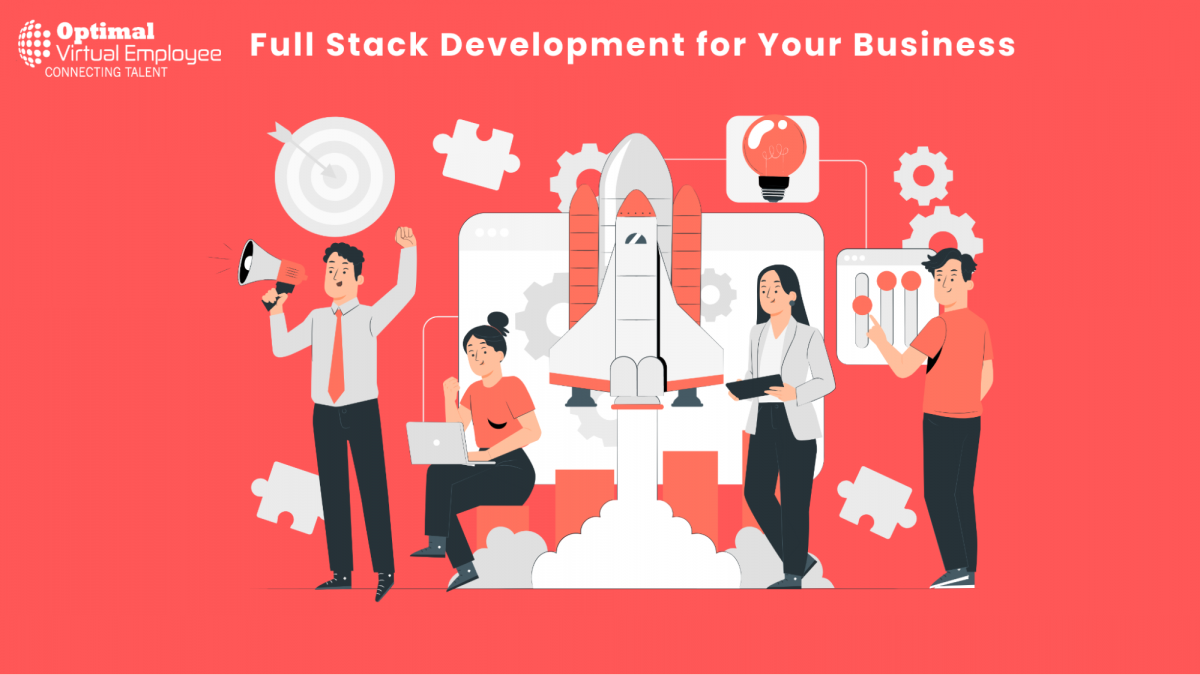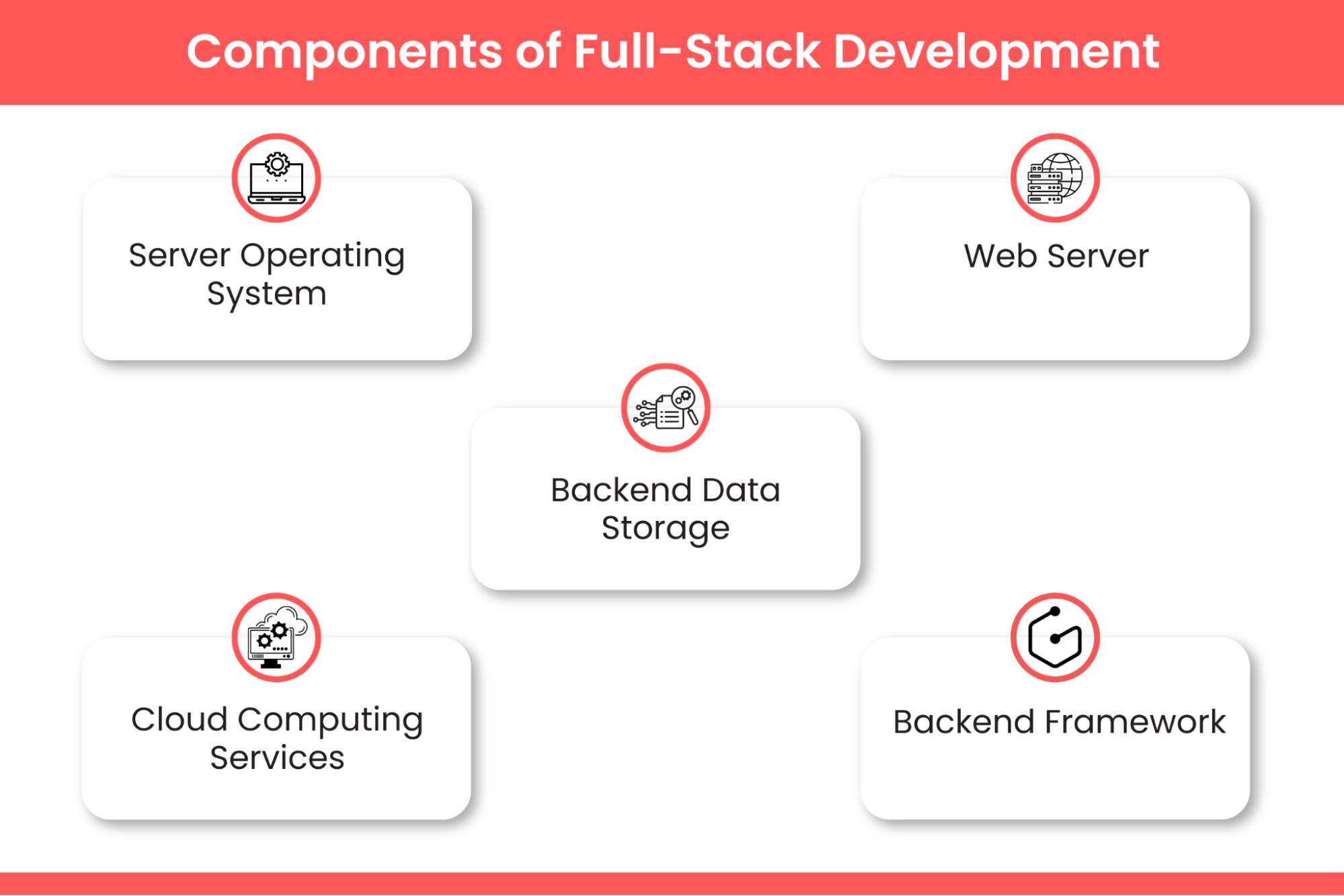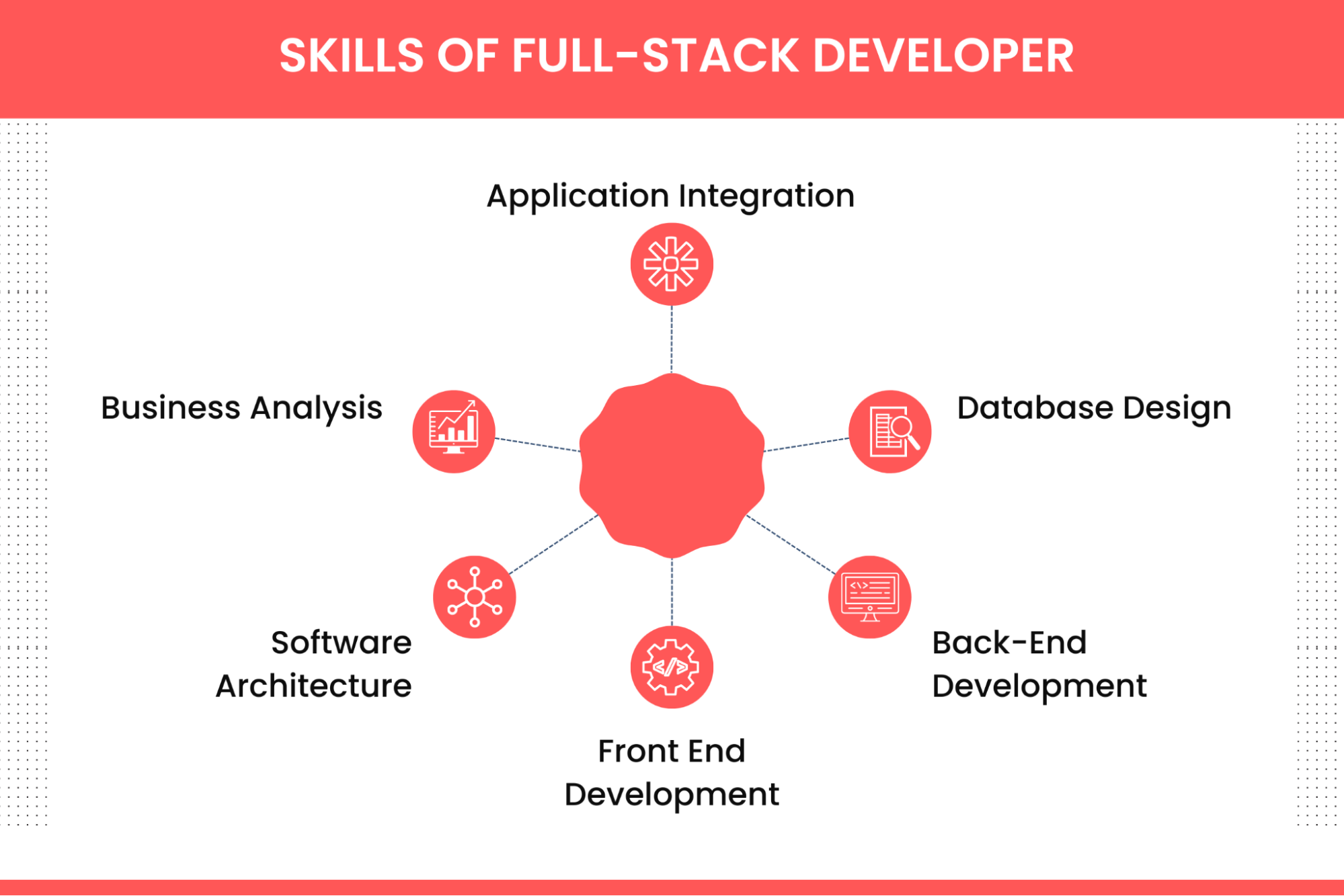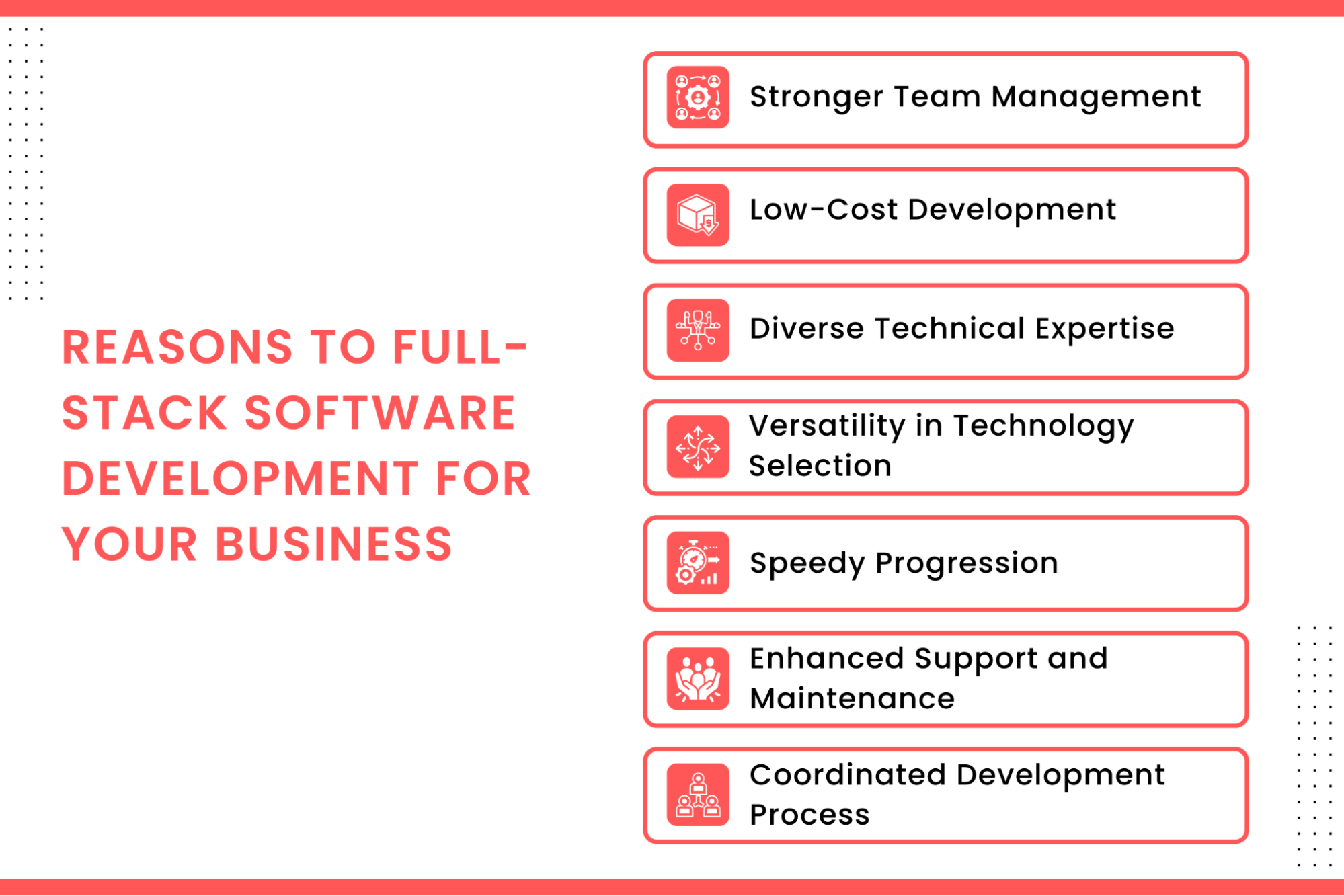Full-stack development has emerged as a popular choice for businesses aiming to cut development costs. But is it merely a cost-saving strategy?
In reality, Full- stack web development has become one of the most in-demand skills in the IT industry, with tech giants like Google and Facebook seeking full-stack developers. This trend is justified, with the web development market predicted to grow by 24% by 2025. Full-stack developers have been among the best positions over the last two years.
What is Full Stack Web Development?
Full stack development integrates both backend and frontend development. Full stack developers are responsible for building the frontend user interface and the backend engine of web applications. The entire team ensures that the front end is engaging, the backend is error-free, and the databases are well integrated.
Why Full-Stack Development is Ideal for Your Business?
With the shift towards digitization, technology stacks prefer hiring Full Stack Development Companies. Being a full-stack developer is favorable in this rapidly growing IT sector.
Full stack development involves a single developer managing both backend and frontend tasks, ensuring the front end is captivating, the backend is without errors, and the database functions well. They provide comprehensive development services.
Full-stack Developer Responsibilities
Hiring a full-stack development company gives access to expert developers throughout the software development process, focusing on
Presentation: Designing the front end using HTML, CSS, and JavaScript.
Logic: Implementing programming with server-side languages like Ruby and Python.
Database: Managing relational and non-relational databases using technologies such as PostgreSQL and MySQL.
Full stack development is more than a cost-saving measure; it’s a strategy that can drive businesses forward in today’s digital age.
What are the Components of Full Stack Development?
Full stack development encompasses the creation of fully functional, robust, and scalable web applications. It’s a complex process involving multiple skills and technologies working together. These components cater to the current and future needs of a business and include
The Server Operating System: This manages the hardware elements of the server and the programs running on them, like Windows Server. Both web and database servers require operating systems to function.
Web Server: Interacting with the web application, it processes all end-user requests. An example of a web server is Microsoft Internet Information Server (IIS).
Backend Data Storage: Comprising the disk storage space and relational database like Microsoft SQL Server, this element stores and retrieves information.
Cloud Computing Services: Offering virtually unlimited scalability for large web applications, popular examples include Amazon AWS and Microsoft Azure.
Backend Framework: These are collections of tools, libraries, and programming languages used on a server to develop web applications, such as the Microsoft ASP.NET framework.
APIs (Application Programming Interfaces): Acting as the communication plumbing, APIs enable data sharing between software systems, irrespective of their underlying technologies.
Frontend Framework: This runs on the browser, dividing the application workload between the user’s computer and the server for greater performance. JavaScript, AngularJS, React, jQuery, and Bootstrap are typical technologies here.
Frontend Languages: HTML and CSS dictate how the web pages are formatted and displayed. They have been integral to web development since the inception of the Internet.
By combining these elements, full-stack development provides a comprehensive approach to building web applications that can efficiently adapt to evolving business requirements. The blend of server-side and client-side technologies ensures a responsive and user-friendly experience across various browsers and devices.
Full Stack Developer Skills
The modern digital landscape demands a multifaceted approach to development. Full-stack developers are key to this, providing a comprehensive skill set that is essential for contemporary businesses. Their abilities encompass various domains, ensuring that they are versatile players in the field of technology. Here’s a closer look at the essential skills:
Business Analysis: Full-stack developers go beyond the code to understand your specific needs and industry goals. This understanding enables them to craft solutions tailored to your business, enhancing efficiency and effectiveness.
Software Architecture: The ability to design solutions that automate workflows is vital. This not only streamlines processes but also liberates employee time, allowing them to concentrate on more crucial aspects of the business.
Front End Development: More than just a “means to an end,” a well-crafted user interface enhances user experience. Full-stack developers are adept at creating interfaces that are both functional and engaging.
Back-End Development: A strong back-end foundation is essential for scalable, agile applications. Full-stack developers possess the skills to build robust systems that can grow with your business.
Database Design: Efficient database design ensures that information is accessible whenever and wherever needed. This enhances productivity and flexibility, moving beyond traditional constraints like spreadsheets.
Application Integration: Full stack developers can seamlessly integrate data from various systems like ERP and CRM tools through APIs. This centralizes critical information, creating a cohesive “source of truth.”
User Interface Design: Quality UI design ensures higher user adoption and satisfaction. Full-stack developers know how to make applications not only functional but also visually appealing.
Cloud Computing: With the increasing shift towards cloud solutions for scalability and flexibility, full-stack developers must be proficient in leveraging cloud technologies for enterprise applications.
Project Management and Communication: Often undervalued but vitally important, effective project management and clear communication keep the project on track. Full-stack developers must be skilled in maintaining transparent communication to prevent misunderstandings that can lead to project failure.
In short, full-stack developers bring a diverse and integral set of skills to the table. Whether it’s business insight or technical expertise, their multifaceted approach ensures that every aspect of a project is handled with finesse and precision. The collaboration with an experienced full-stack developer ensures not only a technologically advanced solution but also a strategic partner who understands and aligns with your unique business goals. Whether working independently or as part of a team offering full-time developers to overseas clients, their role is indispensable in today’s rapidly evolving digital world.
What to Look for in a Full-Stack Developer
When considering Full Stack Development partners, organizations should prioritize those with the experience and expertise that align with their unique needs. However, technical skills alone don’t make a perfect partner; compatibility in terms of work ethics and shared values is equally critical.
A full-stack development company partner should seamlessly integrate with your team, reflecting a shared vision and common business values. This alignment goes beyond the code, turning a partnership into a collaborative and organic extension of your organization.
One must not overlook the importance of solid communication skills. The right partner must be articulate and transparent, ensuring that everyone stays on the same page throughout the development process. Such communication, coupled with the depth of experience, not only reduces development costs but also accelerates the delivery of a viable solution.
For a detailed insight into the attributes of a top-notch full-stack developer, you might consider resources like the “Keene Systems Guide to High Performing Business Applications.”
Full-stack development expertise is no longer an optional luxury; it’s a core competency required by businesses aiming to create and support dynamic web applications. Organizations recognize the essential role of these systems in driving growth, and a scalable team with full-stack development skills can provide the vital resources needed to thrive.
As your business continues to evolve, your systems must adapt accordingly. The right full-stack development company partner will not only be an asset for your current strategies but will also facilitate your growth and transformation over time.
In short, selecting a full-stack development partner is more than just evaluating technical capabilities. It’s about finding a team that resonates with your business ethos, communicates effectively, and has the expertise to transform your visions into reality. With a trustworthy partner, you’re not only investing in a project but in a long-term relationship that supports your business’s continual growth and success. Whether working with an individual or a company offering experienced developers to overseas clients, this partnership will be pivotal in defining your digital journey.
What is a Full Stack Developer?
A full-stack developer is a technological expert proficient in handling both the client (front end) and server-side (back end) of a web application. This comprehensive skill set spans the entire depth of the application, enabling them to create a cohesive and functional product.
Front End Development
The front end encompasses all the elements that a user interacts with directly. It includes the site’s appearance, design, and user experience. Front-end developers use tools like:
– JavaScript, jQuery, Angular, or Vue: for programming the browser
-HTML, CSS: for layout and styling
-Images, Graphics, Animations: for visual appeal
-Content Organization and Navigation: for usability
-They focus on creating an intuitive and visually appealing interface that offers a smooth user experience.
Back-End Development
The back end is the hidden part that operates behind the scenes. It involves
-Programming a server: using languages like PHP, ASP, Python, or Node
-Database Management: handling data storage and retrieval
-Debugging and Troubleshooting: ensuring the application’s stability
-Application Programming Interfaces (APIs) and Architecture: building the core functionality
-Back-end developers work to make the website interactive, secure, and scalable.
The Collaboration of Front End and Back End
A relatable example of this collaboration is the Instagram application. When you refresh your feed, like a picture, or add new content, a seamless user experience is offered. But in the background, HTTP requests are made to the servers, using back-end frameworks to retrieve and load information.
The front end and back end are distinct but interdependent components of the website. Together, they create a dynamic and engaging website that offers users an immersive experience.
Full Stack Development: A Comprehensive Approach
A Full Stack Developer combines both front-end and back-end development skills, managing the entire process from start to finish. This ensures the application’s efficiency, reliability, and other essential features.
Front-End vs. Back-End Development
Front End Developers focus on the client side, using languages and tools like HTML, CSS, and JavaScript to create an appealing user interface.
Back End Developers concentrate on the server side, utilizing technologies like Java, Python, and .Net to develop the core functionality, security, performance, scalability, and responsiveness of the website.
Full Stack Developers play an integral role in bridging the front end and back end of web development. They have the knowledge and skill to create both the visible and invisible parts of a web application, delivering a complete solution. Whether building the application’s architecture or crafting its visual appeal, their multifaceted expertise is vital in today’s digital landscape. As part of a team offering experienced developers to overseas clients or working independently, a Full Stack Developer’s contribution is pivotal in shaping a dynamic, secure, and user-centric web presence.
Front End vs. Back End vs. Full Stack Web Developers: What’s the Difference?
Web development can be broadly categorized into three key roles: Front End, Back End, and Full Stack Development. Understanding the difference between them is crucial for anyone involved in creating or maintaining web applications. Here’s a breakdown:
Full Stack Development
Full Stack Developers are jacks of all trades in the web development world. They utilize both front-end and back-end technologies, seamlessly integrating them to create a complete, user-friendly website or web application. Their goal is to make the website not only visually appealing but also optimally functional.
Client Software (Front End)
Front-end development focuses on the client side of the website, the part that users see and interact with. These developers are responsible for crafting the entire user interface and aesthetic design. Their work is vital in ensuring that users enjoy a seamless experience every time they browse a site.
A professional-looking and efficiently functioning site often depends on front-end developers. They typically work with languages and tools like
CSS3: For styling and layout
JavaScript: For interactivity
HTML: For structuring content
These languages are foundational to creating the visual aspects of the website.
Server Software (Back End)
The back end, in contrast, is the unseen machinery of a website. While the front end is all about user interaction and aesthetics, the back end focuses on functionality and content management. Some of the popular languages used in back-end development include
PHP: Often paired with SQL to create online databases, allowing the front end to retrieve information
Python: Known for its simplicity and efficiency in building server-side applications
CSS: Though typically associated with front-end styling, it also plays a role in back-end processes
A great example of back-end interaction is updating social media profiles or reading news online. You’re likely engaging with these languages without even noticing it. As the volume of information stored on a website grows, the database management aspect becomes increasingly critical.
In Short, the distinctions among Front End, Back End, and Full Stack Developers lie in their areas of expertise and the parts of the web application they focus on
Front End Developers work on the visual side, focusing on the user interface and experience.
Back End Developers handle the hidden mechanics, ensuring content availability and site functionality.
Full Stack Developers bridge both sides, working with all aspects of the site from design to functionality.
Each role plays a unique and vital part in creating and maintaining a cohesive, engaging, and functional web presence. Understanding these roles helps in selecting the right professionals for specific project needs, whether within an individual company or as part of a team offering experienced developers to clients.
Why should you choose full-stack software development for your next project?
So now that you’ve gained an understanding of full-stack solutions and the role of a developer, it’s time to delve into why the majority of contemporary enterprises are increasingly preferring to hire full-stack web developers.
Full-stack developers are at the forefront of streamlining the development process by serving as a unified hub for all requirements. This not only reduces development errors but also allows businesses to leverage their capabilities in a cost-effective manner.
Stronger Team Management
In today’s dynamic business landscape, companies are on the lookout for software developers equipped with not only technical prowess but also exceptional communication skills and the ability to manage a team effectively. This demand is especially pronounced when projects are undertaken by a small team or a handful of individuals.
The full-stack software development approach facilitates the hiring of a compact team, as opposed to requiring specialists for each specific task involved in the development process. Managing a full-stack web development team is far simpler and more efficient. The team members communicate with greater coherence, maintain transparency, and pay meticulous attention to each other’s insights and suggestions.
Low-Cost Development
One of the compelling attractions for businesses to opt for full-stack development companies is the element of cost-effectiveness. Full-stack developers possess the ability to work on all facets of a product, from inception to completion. This holistic approach ensures that you don’t have to invest exorbitantly at the outset of your project. Traditional methods of hiring and managing individual specialists for each segment of development can quickly escalate in terms of time, money, and effort. Conversely, full-stack web developers offer a one-stop solution, managing every aspect of the process. By paying the full-stack developer for all software requirements, they will navigate the entire journey with their team, delivering value at a reduced cost.
Diverse Technical Expertise
Full-stack software development offers the added advantage of tapping into developers with a wide-ranging technological skill set. This is an immense benefit to your company, as full-stack web developers are proficient in various technologies, allowing them to spot and rectify errors with greater agility than other developers. Their unparalleled ability to implement changes and modifications to the product at a faster pace sets them apart. Moreover, they minimize your company’s dependence on engaging multiple developers for a single product, thereby enhancing efficiency.
Versatility in Technology Selection
With full-stack development, the doors are open to utilizing a myriad of technologies to craft your product. The flexibility to select the technology that most align with your requirements adds to the appeal of this approach. Engaging a full-stack developer is not merely a decision grounded in cost savings; it’s a strategic move that enhances efficiency and adaptability in the development process.
The essence of full-stack development lies in its multifaceted nature, encompassing cost-saving measures, diverse technical expertise, and the flexibility to tailor the technological approach to your specific needs. The synergy of these factors makes choosing a full-stack developer a wise investment for businesses looking to navigate the complex landscape of modern development efficiently and economically.
Speedy Progression
Embracing full-stack web development accelerates product delivery, enabling developers to more effectively meet their deadlines. Working together as a cohesive unit, full-stack web developers rapidly coordinate to handle every aspect of the development. With one developer overseeing a multitude of tasks, dependence on other team members is minimized. Collaboration within the team allows for swifter application construction, as a full-stack developer monitors the entire developmental journey.
Studies indicate that full-stack developers can reduce development time by roughly 20% to 25%, affording you extra time to market your product.
Enhanced Support and Maintenance
Full-stack developers are renowned for their ability to adapt to fluctuating circumstances swiftly. This enables them to implement modifications in line with the latest updates, ensuring your product stays ahead of the curve. Full-stack software development streamlines any support-related activities, simplifying the process for developers to inspect and rectify issues. With the entire application development process being handled by a unified team, implementing changes becomes a breeze.
A single full-stack developer can address issues across the front end, back end, and database layers. Having a solitary point of contact for all concerns further facilitates efficient communication. A professional full-stack development company, such as ours, can offer continual support, ensuring that your needs are met around the clock.
Coordinated Development Process
Full-stack web development introduces a more fluid and harmonized workflow, where developers sequentially perform tasks to collectively reach the end goal of product creation. This systematic approach fosters unity in the development process, ensuring a coherent path from inception to completion.
In scenarios where different developers bear individual responsibilities, holding someone accountable for the overall project might be challenging. Full-stack developers, however, oversee every element of the product, from the front end to the back end. This oversight empowers them to fully take charge of the project, embracing ownership and accountability for the entire development journey. Their all-encompassing role facilitates seamless control without any hindrance from other teams, instilling a sense of responsibility and alignment with the project’s objectives.
A Multi-skilled Approach: The Jack of All Trades
Full-stack development represents a comprehensive, all-in-one solution for your enterprise, yielding remarkable boosts in developer productivity. This versatile approach allows full-stack web developers to lead a project independently, work collaboratively within a team, or even partner with other developers to furnish complete development solutions.
The advantage of this multi-faceted role means that you no longer have to invest money, time, and energy in separate web development resources. Everything is combined within the skillset of the full-stack developer, simplifying the entire process.
This one-stop approach is not only beneficial for businesses but also attractive to the developer community. There is a growing trend among developers eager to acquire full-stack web development skills. This surge in interest translates into better career opportunities for individual developers and provides enterprises with access to high-quality, all-encompassing solutions.
In sum, full-stack development breaks down the barriers between different development domains, offering a cohesive and cost-effective approach. It’s an investment in a unified skillset that can lead to more efficient development processes and robust solutions, tailored to fit the ever-evolving needs of modern businesses. Our team of experienced developers is well-equipped to leverage these advantages, delivering top-notch services to our overseas clients.
Full Stack Development: The Voice of Tomorrow’s Technology!
Full-stack development offers solutions to numerous underlying challenges such as inefficiency, miscommunication, developmental obstacles, and delays in delivery. With efficiency and cost-effectiveness being vital in today’s tech landscape, businesses are increasingly turning to full-stack developers. The desire to economize without compromising on quality has made full-stack software development a popular choice.
Full stack development represents a comprehensive method of addressing various issues while maintaining a wide-ranging perspective. The emergence of full-stack developers as essential assets didn’t occur all of a sudden. However, they have now become vital, equipping organizations with both agility and diverse skills.












